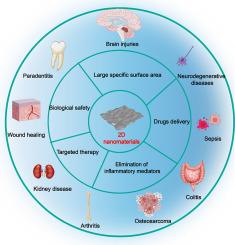Two-dimensional materials for anti-inflammatory applications
Q1 Engineering
引用次数: 0
Abstract
Due to unique physicochemical properties including high surface-to-volume ratio, abundant active sites, and tunable surface functionalities, two-dimensional (2D) materials have emerged as an intriguing platform for anti-inflammatory therapy. This review comprehensively explores the physicochemical characteristics, types, and anti-inflammatory mechanisms of representative 2D materials, including MXenes, black phosphorus (BP), transition metal dichalcogenides (TMDs), boron nitride (BN), metal-organic frameworks (MOFs), and layered double hydroxides (LDHs). These materials exhibit intriguing anti-inflammatory mechanisms, such as scavenging reactive oxygen/nitrogen species (ROS/RNS), regulating cytokine networks, inhibiting pro-inflammatory signaling pathways, and promoting macrophage polarization. Furthermore, their applications in treating diverse inflammatory diseases are summarized, including accelerated wound healing via ROS elimination, colitis therapy through gut microbiota modulation, mitigation of acute kidney injury (AKI) via oxidative stress reduction, and rheumatoid arthritis (RA) and neurodegenerative disorders treatment via neuroimmune regulation. Critical challenges in clinical translation, such as biodegradability and long-term biocompatibility, are addressed. This review underscores the vital role of 2D anti-inflammatory materials in bridging material science with biomedical field, offering insights into the design of future anti-inflammatory drugs.

抗炎应用的二维材料
由于其独特的物理化学性质,包括高表面体积比、丰富的活性位点和可调节的表面功能,二维(2D)材料已成为抗炎治疗的一个有趣的平台。本文综述了MXenes、黑磷(BP)、过渡金属二硫族化合物(TMDs)、氮化硼(BN)、金属有机骨架(mof)和层状双氢氧化物(LDHs)等具有代表性的二维材料的理化特性、类型及其抗炎机制。这些材料表现出有趣的抗炎机制,如清除活性氧/氮(ROS/RNS),调节细胞因子网络,抑制促炎信号通路,促进巨噬细胞极化。此外,综述了它们在治疗多种炎症性疾病中的应用,包括通过消除ROS加速伤口愈合,通过调节肠道微生物群治疗结肠炎,通过氧化应激减少急性肾损伤(AKI),以及通过神经免疫调节治疗类风湿性关节炎(RA)和神经退行性疾病。解决了临床翻译中的关键挑战,如生物可降解性和长期生物相容性。本文综述了二维抗炎材料在材料科学与生物医学领域之间的桥梁作用,为未来抗炎药物的设计提供了新的思路。
本文章由计算机程序翻译,如有差异,请以英文原文为准。
求助全文
约1分钟内获得全文
求助全文
来源期刊

Smart Materials in Medicine
Engineering-Biomedical Engineering
CiteScore
14.00
自引率
0.00%
发文量
41
审稿时长
48 days
 求助内容:
求助内容: 应助结果提醒方式:
应助结果提醒方式:


